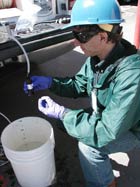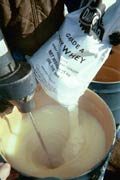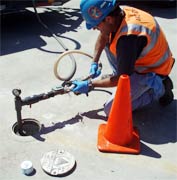Contact Pacific Southwest Waste Program
Pacific Southwest, Region 9
Serving: Arizona, California, Hawaii, Nevada, Pacific Islands, Tribal Nations
Restoring the Romic Property for a Cleaner Future
Video Summary
EPA has proposed a remedy to clean up soil and groundwater contamination at Romic Environmental Technologies Corporation. Romic is a 14-acre hazardous waste management facility located in East Palo Alto, California. Historical facility operations included solvent recycling, fuel blending, wastewater treatment and hazardous waste storage and treatment. Waste management practices dating back to the 1950's resulted in the contamination of soil and ground water below the facility. The primary contaminants in the soil and ground water are volatile organic compounds (VOCs). Typical VOCs include dry cleaning chemicals, carburetor cleaning liquids, paint thinners and chemicals used to manufacture computers. As the lead agency for soil and groundwater cleanup, U.S. EPA invites the public to comment on our clean-up proposal, summarized in the U.S. EPA fact sheet:
- Romic - Statement of Basis (PDF) (64 pp, 717K, About PDF)
- Romic - Final Fact Sheet - English (PDF) (4 pp, 2.9M, About PDF)
- Romic - Final Fact Sheet - Spanish (PDF) (4 pp, 1.8M, About PDF)
- Press Release (9/17/07)
- Romic East Palo Alto webpage
U.S. EPA’s recommendations are made in the context of the impending closure of Romic East Palo Alto. The facility ceased accepting waste as of August 3, 2007. Facility owners will convert the site to new uses. U.S. EPA anticipates addressing issues related to site closure and reuse in the implementation of the cleanup.

The Romic Environmental Technologies facility has stored and treated hazardous wastes for 43 years.

U.S. EPA Project Manager Ron Leach has worked with state regulatory agencies and local community representatives to evaluate cleanup approaches.
Proposed Cleanup Approach
The proposed plan of action for contamination at Romic relies on enhanced biological treatment as well as other approaches. The enhanced biological treatment uses cheese whey and molasses as a food source for natural microbes that live in the soil and ground water below the Romic facility. These microbes break down the contaminants into carbon dioxide, water and salt. Tests of this technology at the Romic facility have shown as much as a 99% decrease in the amount of contamination. Implementing the remedy site-wide will require installation of a few hundred more injection wells than the 60 which now exist. Thereafter, the molasses solution will be injected throughout the property. U.S. EPA hopes to use this technology at more cleanup sites in the future, because it demonstrates rapid and effective results using inputs which are non-harmful (in this case, food-grade products), while using less energy resources than traditional pumping and treating of groundwater.

The proposed remedy uses cheese whey and molasses as a food source for microbes living in the soil and groundwater.

The cheese whey and molasses solution is pumped from a mixing tank into wells.
In addition to the enhanced biological treatment, the proposed remedy calls for:
- Soil excavation where needed
- Financial assurance mechanisms requiring Romic to set aside money (including a $1.5 million surety bond, and possibly other financial resources) to ensure that corrective action will be completed.
- Land use restrictions limiting future property use
While U.S. EPA is overseeing soil and groundwater cleanup, the California U.S. Department of Toxic Substances Control (DTSC) will be addressing facility closure, requiring Romic to submit a closure plan for DTSC review addressing decontamination of equipment, safe demolition of structures, cleanup of any contamination under these structures, final disposal of wastes, and other matters.
Future Redevelopment of Romic
U.S. EPA Support for
Environmental Projects in East Palo Alto
For the past decade, The U.S. EPA has been working through Brownfields grants, worker training programs, asthma assessments, and other programs to improve the human health and environment of the East Palo Alto community. History of the U.S. EPA Involvement with East Palo Alto (PDF) (2 pp, 149K, About PDF)
Regulators, community members and facility representatives have been working on a cleanup strategy for Romic for years and the recent announcement to close Romic brings potential challenges to the cleanup planning process. U.S. EPA’s approach emphasizes that cleanup and reuse are complementary goals and consideration of anticipated property reuse will be an integral part of U.S. EPA’s cleanup decisions. The remedy is designed to allow for flexibility as redevelopment requires, such as phasing areas of cleanup in the order in which they will be redeveloped and modifying the extent of soil excavation as needed.
The community of East Palo Alto may benefit from the redevelopment which could generate new business for the community and additional revenues for the city, while at the same time resulting in a cleaner environment.
